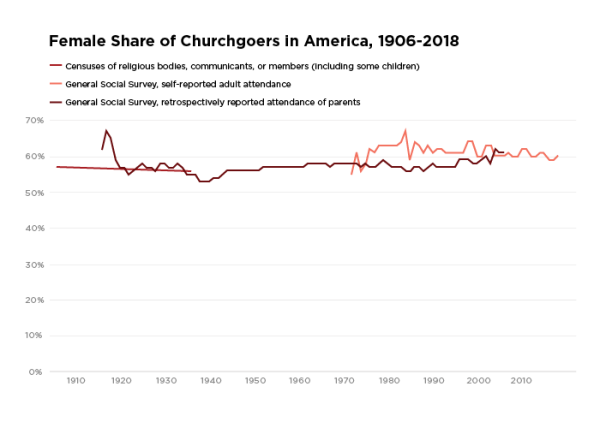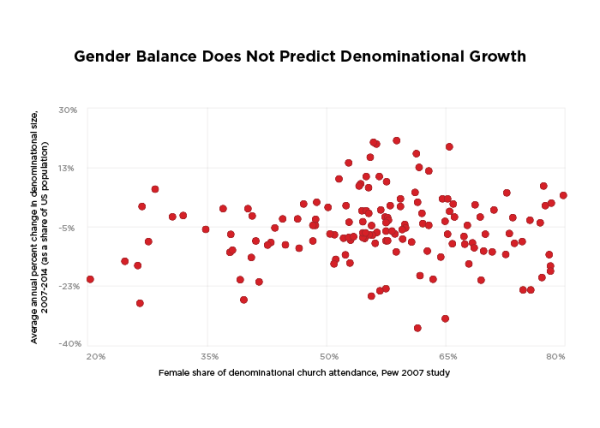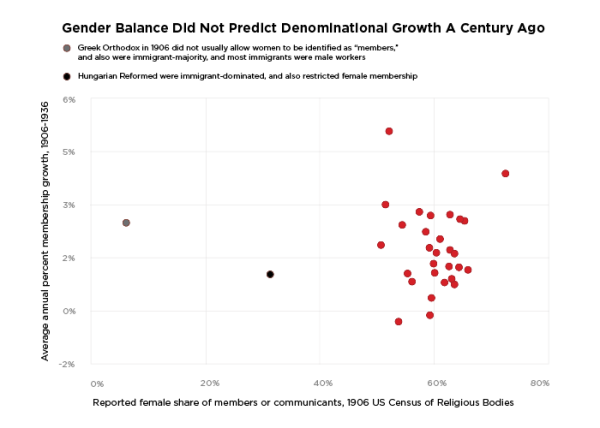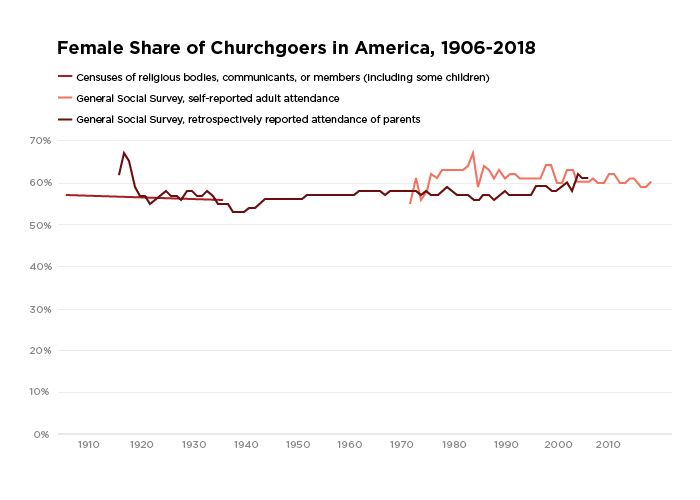“There’s a crisis of men in the church.” You’ve undoubtedly heard this said in various iterations at various times. Mark Driscoll, former pastor of the now-disbanded male-dominated Mars Hill Church in Seattle, often made claims like, “The problem with the church today … it’s just a bunch of nice, soft, tender, chick-ified church boys,” or “sixty percent of Christians are chicks and the forty percent that are dudes are still chicks.”
The Canadian psychologist Jordan Peterson has also touched this nerve among Christian men. Most recently, Owen Strachan, director of the Center for Public Theology, kicked up this perennial conversation with a podcast and related tweet on the nature of manhood.
As the argument goes, “Where men go, churches grow,” or, alternatively, “Where men lead, women follow,” both implying that having a large number of women is bad for church growth. Scores of articles and books on the demise of Christian masculinity have cropped up, from David Murrow’s Why Men Hate Going to Church to Leon Podles’ The Church Impotent, creating a veritable industry advancing the idea that Christian manhood is under threat. The book sales have been impressive, so the ideas must be sound, right?
Wrong. It turns out that Christianity is no more “feminized” today than it was 50 years ago, 100 years ago, 300 years ago, a thousand years ago, or even in the first century of the church. Those who argue that church growth depends on special, male-focused activities—or especially “masculine” programming—mistake the historic record of the church and also imperil the church’s historic teachings on sex.
Ancient sources are unequivocal: From the start, Christianity was overwhelmingly a female religion. The fourth-century church father Cyril of Jerusalem opens his famous Catechetical Lectures by addressing the men in the congregation. He says:
Possibly too you have come on another pretext. It is possible that a man is wishing to pay court to a woman, and came hither on that account. … I accept this bait for the hook, and welcome you, though you came with an evil purpose, yet as one to be saved by a good hope.
Here, in one of the most famous early Christian texts about how to teach the faith, the pastor opens up by saying essentially, “Look, I know you dudes are only here because your fiancées are forcing you to be here.”
The conversion of women to Christianity was so prominent that in A.D. 370, the Emperor Valentinian had to order the pope to cut it out and stop sending missionaries to knock on the doors of pagan women. Historians are in virtually uniform agreement that converts to early Christianity were disproportionately upper-class women (and, separately, slaves and ethnic minorities).
There were many reasons for this, but the religious historian Rodney Stark has compiled an impressively large collection of historic data showing that one major reason may have simply been that Christianity treated women better, not least because Christians placed less pressure on women to speedily remarry if their husbands died. They also placed less pressure on young girls to marry.
In making his case, Stark reports an interesting anecdote from A.D. 303 during a wave of persecution. Officials busted up a house church and seized the goods the Christians had gathered to distribute to the needy: 16 men’s tunics and 82 women’s tunics. Since time immemorial, church ladies have been absolutely wiping the floor with the men when it comes to pledge drives.
From catechetical manuals to church aid efforts to the primary-source accounts of ancient people, the picture is pretty clear: Christianity was disproportionately female.
Dating Evangelism or Marriage Evangelism?
Stark also points out that, because the Roman world abandoned or killed many female babies, it had very imbalanced sex ratios: about 130 men for every 100 women, worse than China today. As a result, there were a lot of Roman dudes who had a hard time finding a wife. Since Christianity was majority female, a lot of Christian women had a hard time finding a husband. (If this scenario sounds familiar, there’s a reason: It’s very similar to the situation faced by Christian women today.)
As a result of this imbalance in ancient times, Christian women often married pagan men. The New Testament, especially Paul’s letters, repeatedly addresses religiously divided households. (See 1 Corinthians 7:12–16 and other passages.) In the contest between a pagan husband and a Christian wife, Christianity usually won. That’s the big difference between ancient and modern churches on this issue. Ancient Christians were never shy about attributing faith to Christian motherhood: Timothy’s faith is credited to his mother and grandmother. St. Augustine credited his faith to his mother. And I already mentioned Cyril’s lectures, which provide implicit proof that a lot of pagan men took crash courses in Christianity in order to marry Christian women.
There are also many prominent cases of Christian wives changing history. The mistress of the emperor Commodus, Marcia, interceded to save the life of a future pope. Clotilde, the wife of the barbarian king of the Franks, Clovis, was instrumental in his conversion and thus to the evangelization of France. Indeed, a considerable share of the yeoman’s work to expand Christianity was probably done by Christian women in mixed marriages.
Evidently, the early Christian community was characterized by lots of Christian women marrying non-Christian men and then, with steely eyed determination, dragging their husbands and kids to church until they finally surrendered themselves to the mercy of Christ. The early practice of infant baptism probably helped this process along, as Christian wives could use the ritual to “stake a claim” to the faith of their children, leaving their pagan husbands playing catch-up. That American Protestants often don’t baptize babies (and have fewer babies than in the past) might explain why marriage isn’t as effective an evangelization route as in the past.
On that latter point, for virtually all of Christian history, a large share of growth in the church has come from fertility. A church with a lot of men and few women is a church that is one generational step away from extinction. The opposite, then, also holds true: Churches with women are churches with babies and thus with future growth. Women were numerous in early Christianity, so their fertility propelled the strong, natural growth of the Christian population, in contrast to the stagnant pagan population.
American Christianity Has Always Been Female Dominated
The long history of female majorities at church is conceded even by many of those who advance the “crisis of manhood” narrative. For example, a long article on the Art of Manliness website details how the early American church was massively female dominated. The article provides quotes from various religious historians, eyewitness accounts from the 18th and 19th centuries, and data taken directly from church records, all showing that Christian churches in America were probably about 60 to 80 percent female at least until the mid-19th century.
By the 20th century, we had reliable data sources. From 1850 to 1936, the U.S. Census Bureau conducted a Census of Religious Bodies, asking every church and denomination in America to report various key statistics about itself. Beginning in 1906, those statistics included reporting on the gender of members. Additionally, since 1972, the General Social Survey (GSS) has collected sufficient data to estimate the female share of church attendees. And in a few waves, the GSS also asked respondents about the childhood attendance patterns of their parents, making it possible to estimate at least the share of mothers who attended church all the way back to the early 20th century.

The data in this graph is quite dull, but it drives home the point: There’s been no notable change in the gender composition of Christianity in recent years. The entire story about the decline of Christian men is fake news. We’re showing up, or not, just as we always have. As has been the case from the Virgin Mary until now, Christian women are simply far more prominent in the day-to-day life of the church than Christian men. In other words, the unfortunate reality of male religious complacency is not new, and it’s also not an existential threat to the church.
This trend isn’t strictly American either. Recent international surveys show that Christianity has a female bias in virtually every country. In both Christian and many Muslim countries, women pray more often than men. The evangelistic, conservative, fast-growing churches of Africa are majority female, just like the declining, cloistered, progressive, and state-sponsored churches of Europe.
More Men Doesn’t Mean More Growth
The controversial implication of the “crisis of men” narrative is that supposedly, when there aren’t enough men in the pews, the church will eventually shrink. Insufficiently “masculine” churches are presumed to invite their own demise.
This claim is testable, and it happens to be completely false. The graph below plots the female share of church attendance across each Christian denomination in Pew’s 2007 Religious Landscape Survey against each group’s growth or decline as a percentage of U.S. population between Pew’s 2007 and 2014 surveys.

As evidenced by the graph, there’s no meaningful correlation between the gender balance of church attendance and church growth. Making your church manlier won’t make it bigger.
Some denominations may object to my method since I’m using survey data and not denominationally reported membership. However, I tested the relationship using denominational membership in a sample of 35 large denominations, using Pew’s gender balance data and denominationally reported church growth between 2007 and the present. Once again, no relationship exists. The gender balance of a religious community has very little connection to church growth.
It’s true today, and it was true a century ago. The graph below charts denominational growth for 31 denominations between 1906 and 1936 and compares it to their gender ratio in 1906.

Again, there’s no relationship. Denominational growth simply has nothing to do with sex ratios at church.
The Real Problem Goes Beyond Gender
Here’s the bottom line, then: All the complaining about the “end of men” at church is overwrought and unjustified. Since its earliest years and in every period since, Christianity has been a majority-female religion. That isn’t going to change anytime soon.
With this information in mind, Paul’s injunctions about men and women (in 1 Timothy 2–4 and elsewhere) suddenly sound a bit different. Paul gives detailed instructions for how women should behave, perhaps because the churches he was preaching to were overwhelmingly composed of women who were married to non-Christian men and wondering in very practical terms how to set examples for their families.
Meanwhile, when Paul speaks to men, he often talks about leadership roles, perhaps because a large share of Christian men were in such roles. If the early church really was 70 percent women, if average church sizes were small due to a lack of designated spaces, and given the high rates of monasticism in Christianity from the second century onward, it’s likely that the majority of regularly church-attending men in the early church were congregational leaders, church workers, or celibate.
None of this changes any doctrines that churches teach. Readers looking for support for the ordination of women may perhaps be happy to hear that women were a huge part of the early church and that making church manlier won’t drive growth. But readers looking for support for the traditional restriction on female ordination will also be reaffirmed. Even though Paul was writing to churches with gender balances as or more lopsided than today’s, he insisted on a male pastorate and leadership.
My aim here is not to challenge either of these readings. It’s simply to challenge the view that the reason Christianity is declining in America is that it has become too feminized. This view is wrong: American Christianity today has almost precisely the same gender balance as every other Christian society.
So can (or should) anything be done about the gender imbalance?
The international surveys shown above did suggest a reason for women’s greater religiosity. Women who had employment outside the home (and especially women who worked full-time and had no children) had about the same religiosity as men (and in most countries, 85% or more of working-age men work full-time). Women with working lives like men’s tend to be about as irreligious as men.
In other words, the major problem facing churches today is probably not that they have an insufficient number of men but that they made too many compromises with the avaricious, work-and-career-focused consumer culture of the modern Western world. Faith is always homemade, and work outside the home is secularizing for men and women. The church chose to worship Mammon, and the worship of God has naturally suffered.
By tacitly accepting the view that paid work (and the schooling that prepares a person for paid work) should be the central part of a person’s life, the dominant element of a person’s schedule, and the primary component of a person’s social identity, churches have surrendered vital ground. In order to grow, churches would be better off making fewer compromises with worldly success, encouraging vows of poverty, and renewing ascetic disciplines. Rather than getting more bearded pastors, we should exhort the wealthy in our churches to give 20, 30, 70, or 90 percent of their incomes.
Pastoral counseling should encourage parishioners to consider whether they really need to work as much as they do, whether they could not perhaps live on less. When our sons and daughters consider college, we should urge them to consider the perils of student loans—not that they will take on too much debt but that they will have to devote too much of their lives to paid work and not enough to their churches and their families to pay off those loans. A revival in the church will not be sparked by manliness, but it may be sparked by taking up our cross daily and denying the world.
Lyman Stone is an adjunct fellow at the American Enterprise Institute, a research fellow at the Institute for Family Studies, and the chief intelligence officer of the consulting company Demographic Intelligence.












